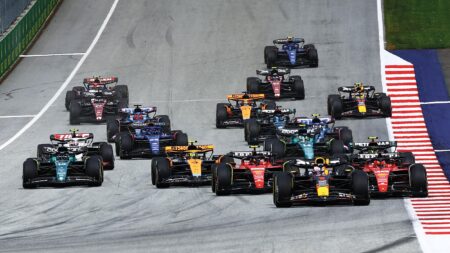
McLaren steals a march on F1’s ‘best-of-the-rest’ as Verstappen still dominates
For a team in the midst of setting new Formula 1 records, Red Bull had quite a few headaches to deal with in this part of the season – and…
A simple but stylish design that looks good from every angle, the Austin-Healey 3000 may just be the epitome of the 1960s British sports car with its low-slung stance, long bonnet and wire wheels, not to mention a strong motor sport pedigree. Many regard it as such today, although America seems to have reached that conclusion more than half a century ago — the majority of sales were made ‘across the Pond’, a British invasion that predated even The Beatles.
The 3000, launched in 1959, stands in a line of so-called ‘Big Healeys’ dating back to the 100 that hit the market in 1953. When Donald Healey, an engineer at Triumph and a Monte Carlo Rally winner before World War II, launched his Austin-powered roadster at the previous year’s London
Motor Show at Earls Court, he attracted the attention of the British Motor Corporation. A deal for BMC to build the new design at its Longbridge plant followed suit and the Austin-Healey was born as we know it.
The car grew into the 100/6 in 1956 with a major redesign around a bigger body, a lengthened wheelbase and a 2.6-litre six-cylinder engine. Another increase in capacity of the BMC C-series powerplant three years later created the most famous ‘Big Healey’ of them all, a retrospective moniker that distinguishes the car from the Austin-Healey Sprites.
The 3000 had disc brakes up front, but the body and chassis were unchanged on a car that was available, like its predecessor, as a two-seater and a 2+2, codenamed the BN7 and the BT7 respectively.
“The 3000 wasn’t built with racing or rallying in mind, but it had potential”
A Mark 2 version of the car arrived in 1961 with triple SU carburettors and that distinctive Healey grille with vertical bars. Early in the life of this second-generation car, what Healey called the ‘sports convertible’ was introduced with a fold-down roof. The BJ7 was a significant development for Austin-Healey owners who previously had had to retrieve the soft top from the boot on signs of inclement weather.
This led into the third iteration of the 3000, designated the BJ8. A 2+2 only, now with two carbs again, this latest variant was aimed squarely at the eager North American market. That’s where the majority of cars ended up before production of what was now an ageing design ended in 1968.
The Austin-Healey 3000 hadn’t been conceived with racing or rallying in mind, but the BMC Competitions department spotted its potential. The car competed at the Sebring and Le Mans endurance classics, but it was on the open-road time trials across Europe that the 3000 enjoyed greatest success, Pat Moss famously winning the Liège-Rome-Liège Rally in 1960. There was a near-miss on the forest stages of the RAC Rally, too, Timo Mäkinen finishing a close second to his BMC team-mate Rauno Aaltonen in a Mini in 1965.
The third-generation cars are the most desirable today. There are rarities from the production life of the car that can command similar or even higher values, but the later 3000s are certainly the easiest to live with on the open road.
The folding hood, wind-up windows, an increased ride height, a longer final-ratio gearing and a tad more power courtesy of a high-lift cam and bigger carbs make the Mark 3 a better drive than its predecessors. A plusher interior incorporating a wooden dash and more exterior chrome arguably make it even more beautiful on the eye, too.
The threat of rust, as you might expect of a British-made vehicle of the 1960s, can be a problem. The Big Healeys tend to capture water in the inner and outer sills, the bottom of the wings and the boot. But repairs are relatively straightforward and complete body shells are available from British Motor Heritage.
• Price new £1300
• Price now £35,000-125,000
• Engine 2.9-litre normally aspirated straight-six
• Power 117bhp
• 0-60mph 11.7sec
• Top speed 115mph
• Rivals Triumph TR2 & TR3, Sunbeam Alpine, Jaguar XK150
• Verdict A great British sports car with enduring appeal